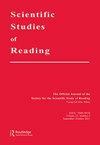Even in predictable orthographies: Surface dyslexia in Turkish
IF 2.4
2区 教育学
Q1 EDUCATION & EDUCATIONAL RESEARCH
引用次数: 3
Abstract
ABSTRACT Purpose We report here, for the first time, on developmental surface dyslexia in Turkish, a very transparent orthography. Surface dyslexia is a deficit in the lexical route, which forces the reader to read words via the sublexical route, leading to regularization errors. Methods To detect surface dyslexia, we used reading aloud of loanwords with irregular conversion of vowel length or consonant allophone, and analysed regularization errors. We also tested the properties of this dyslexia using lexical decision on pseudohomophones, repetition and reading of nonwords, and analyses of reading of different types of words. The children with surface dyslexia were identified out of 175 9–10-year-olds who were tested using a reading aloud screening task and tasks that were designed to detect sublexical (rather than lexical) reading of existing words. Results We identified 45 fourth-graders with surface dyslexia. Reading speed was less sensitive to surface dyslexia than regularization errors, as only one-third of the children we diagnosed with surface dyslexia according to their reading errors also showed slower reading than controls. A task of lexical decision of pseudohomophones indicated that 31 of the participants had impairment in the orthographic input lexicon, whereas for 14 others the orthographic input lexicon was intact and the deficit is probably at a later stage in the lexical route – the phonological output lexicon or the connection between the lexica. Nonword reading was intact for the majority of surface dyslexia participants (35 of the 45). None of the surface dyslexia participants showed phonological deficits. Conclusions Surface dyslexia can be identified even in transparent orthographies once the relevant stimuli and error analyses are used.即使在可预测的正字法中:土耳其语的表面阅读障碍
摘要目的我们首次报道了土耳其语的发展性表面阅读障碍,这是一种非常透明的正字法。表面阅读障碍是一种词汇路径上的缺陷,它迫使读者通过亚词汇路径阅读单词,从而导致正则化错误。方法通过朗读元音长度或辅音音素转换不规律的外来词来检测表面阅读障碍,并分析正则化误差。我们还通过对假同音异义词的词汇判断、非词的重复和阅读以及对不同类型词的阅读分析来测试这种阅读障碍的特征。在175名9 - 10岁的儿童中,研究人员通过大声朗读筛选任务和旨在检测对现有单词的亚词汇(而不是词汇)阅读的任务,对这些儿童进行了表面阅读障碍的检测。结果我们发现45名四年级学生有表面阅读障碍。阅读速度对表面阅读障碍的敏感性低于正则化错误,因为根据阅读错误诊断为表面阅读障碍的儿童中,只有三分之一的儿童也表现出比对照组更慢的阅读速度。假同音同义词的词汇判断任务表明,31名被试在正字法输入词汇方面存在缺陷,而14名被试在正字法输入词汇方面是完整的,这种缺陷可能发生在词汇路径的后期阶段——语音输出词汇或词汇之间的联系。大多数表面阅读障碍参与者(45人中有35人)的非单词阅读能力完好无损。表面阅读障碍的参与者没有出现语音缺陷。结论通过相关的刺激和误差分析,即使在透明的正字法中,也可以识别出表面阅读障碍。
本文章由计算机程序翻译,如有差异,请以英文原文为准。
求助全文
约1分钟内获得全文
求助全文
来源期刊

Scientific Studies of Reading
Multiple-
CiteScore
7.20
自引率
2.70%
发文量
26
期刊介绍:
This journal publishes original empirical investigations dealing with all aspects of reading and its related areas, and, occasionally, scholarly reviews of the literature, papers focused on theory development, and discussions of social policy issues. Papers range from very basic studies to those whose main thrust is toward educational practice. The journal also includes work on "all aspects of reading and its related areas," a phrase that is sufficiently general to encompass issues related to word recognition, comprehension, writing, intervention, and assessment involving very young children and/or adults.
 求助内容:
求助内容: 应助结果提醒方式:
应助结果提醒方式:


